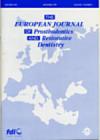European Journal of Prosthodontics and Restorative Dentistry

- Cover Date:
- September 2006
- Print ISSN:
- 0965-7452
- Vol:
- 14
- Issue:
- 3
Abstracts
Abstracts
A series of abstracts presented at the 2006 British Society for the Study of Prosthetic Dentistry in Edinburgh. Abstracts were selected on the basis of there scientiï¬c merit by members of the Editorial Board of the Journal Effect of curing cycle on the tensile bond strength of heat cured denture base acrylic resin to acrylic resin denture teeth. A Dalal, A.S Juszczyk, D Radford, RKF Clark. GUY’S TOWER, LONDON Aims: To determine the effect of three different curing cycles on the tensile bond strength of the join between three brands of heat cured denture base acrylic resin and one brand of cross-linked acrylic resin teeth. Materials and Methods: Specimens were prepared following American Dental Association (ADA) speciï¬cation No.15. Cross-linked acrylic resin denture teeth (Enigma). were sectioned to produce 1.5mm thick discs that were incorporated into acrylic resin dumbbells made from three different heat cured denture base acrylic resins (Trevalon C, Meadway and Pegasus Plus) The specimens were cured following long, medium and short curing cycles. The tensile bond strength of ï¬fteen specimens for each combination was tested using an Instron 1195 Universal testing machine. Results: The two-way ANOVA showed a statistically signiï¬cant difference (p<0.05) between the tensile bond strength of the three heat cured denture base acrylic resins and the three curing cycles used. A one-way ANOVA showed a statistically signiï¬cant difference (p=0.018) between the three heat cured acrylic resins processed using the medium curing cycle. A post-ANOVA Scheffe comparison test conï¬rmed a difference (p=0.031) between Trevalon C and Pegasus Plus materials processed by the medium curing cycle. Statistically signiï¬cant differences (p=0.035) were also observed between the three curing cycles used for Pegasus Plus acrylic resin. A post-ANOVA Scheffe comparison test showed a marginal difference (p=0.057) between the Pegasus Plus specimens processed using the short and the medium cycles. Conclusions: The short curing cycle produced specimens with the lowest tensile bond strength irrespective of the type of heat cured acrylic resin used. Long and medium curing cycles produced specimens with acceptable tensile bond strength when compared to the ADA speciï¬cation No.15. Pegasus Plus, produced specimens with the highest tensile bond strength. Influence of Inter-implant Distance and Type of Attachment on the Retention of Mandibular Overdentures on Two Implants. Initial and Fatigue Retention Values. G Michelinakis, D Doukas, CW Barclay, PW Smith. HERAKLION DENTAL PRACTICE, CRETE Aims: This in vitro study aimed to investigate the influence of (1) the inter-implant distance and (2) the type of attachment on the initial and fatique retention of mandibular overdentures. Materials and Methods: At distances of 19, 23 and 29mm apart, three different mandibular overdenture attachments were secured onto analogues; Hader bars, ball abutments and NdFeB magnets. 45 groups of paired attachments were tested and again after a simulated 6-month use, at the three inter-implant distances. Results: For initial retention values, inter-implant distance played a signiï¬cant role. When the inter-implant distance was set at 29mm, then the ball abutments showed statistical superiority against all other attachments. Magnets were found to be statistically the least retentive attachment type. Conclusions: For the simulated long-term use, inter-implant distance had a signiï¬cant effect on the retention. Inter-implant distance can affect the initial retention of mandibular overdentures on two implants depending on the type of the attachment used. Associations between clinical parameters and the prevalence of occlusal interference in unopposed posterior teeth. H Craddock, CC Youngson, M Manogue. LEEDS DENTAL INSTITUTE Aims: To examine occlusal changes following posterior tooth loss and investigate their relationship to dynamic tooth contacts in the form of occlusal interferences. Materials and Methods: Patients with an unopposed posterior tooth and matched control patients from Leeds Dental Institute were studied. An occlusal examination was carried out, study models were scanned and measurements were made of a number of dental parameters. Results: 53% of subjects with unopposed posterior teeth have one or more occlusal interferences associated with the site, compared with 12% of the control group. Each type of contact or interference was modelled using Generalised Linear Modelling. Conclusions: Unopposed posterior teeth are more likely to be involved in a functional contact or interference than their matched controls. Many teeth are involved in multiple interferences and there appear to be a number of interrelationships between these. Effects of processing technique on the surface roughness of denture s with acrylic resin bases. A Elkartia, JF McCord. MANCHESTER DENTAL HOSPITAL Aims: The aim of this trail was to investigate the impression surface roughness of acrylic denture bases processed from two different processing techniques viz. a conventional moulding technique and an injection moulding technique. Materials and Methods: A total of forty-ï¬ve maxillary denture bases were prepared in dental wax. They were
- Article Price
- £15.00
- Institution Article Price
- £
- Page Start
- 137
- Page End
- 141
- Authors
Articles from this issue
- Title
- Pg. Start
- Pg. End
- Cyclic Loading of Endodontically Treated Teeth Restored with Glass Fibre and Titanium Alloy Posts: Fracture Resistance and Failure Modes.
- 98
- 104
- Assessment of The Oral Health Related Quality of Life of Patients Awaiting Initial Prosthetic Assessment.
- 111
- 115
- The Investigation of Solubility Values, Water Sorption and Bond Strength of Auto-polymerising and Heat-polymerising Acrylic Resin Materials
- 116
- 120
- EJSept 06 627-TürkeEffect of Five Staining Solutions on the Colour Stability of Two Acrylics and Three Composite Resins Based Provisional Restorations r pp121-125.pdf
- 121
- 125
